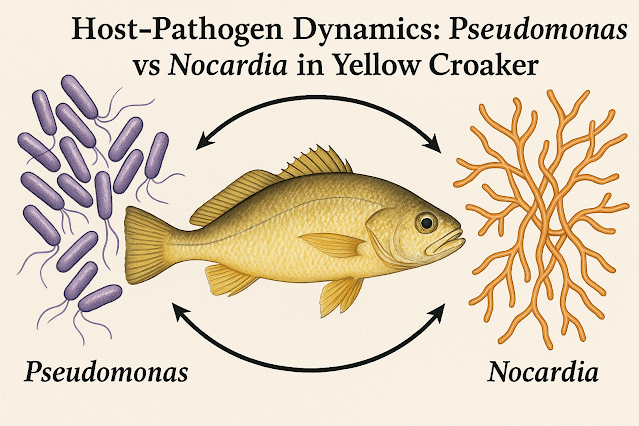INTRODUCTION
Nocardia seriolae and Pseudomonas plecoglossicida are emerging as major pathogens in aquaculture, especially due to their involvement in visceral granulomatous disease in economically significant fish species like the large yellow croaker (Larimichthys crocea). Despite their growing impact, the specific differences in host-pathogen interaction dynamics between these two bacterial species remain largely unexplored. In this study, comprehensive cellular and molecular analyses were conducted using a head kidney-derived cell line from yellow large croaker (LYC-hK) to investigate the distinct effects of both pathogens. Observations included ultrastructural changes via transmission electron microscopy, cellular damage through lactate dehydrogenase release, oxidative stress by ROS measurement, apoptosis, ferroptosis indicators, and comparative transcriptomic profiling. The integrated analysis helps elucidate bacterial strategies of immune evasion, cellular manipulation, and intracellular survival mechanisms. This study offers new perspectives into the pathogenesis of fish granulomatous infections and underscores the necessity for targeted therapeutics and immune interventions tailored to specific pathogens in aquaculture settings.
CELLULAR ULTRASTRUCTURE AND INTRACELLULAR PATHOGENESIS
The ultrastructural changes induced by N. seriolae and P. plecoglossicida in LYC-hK cells provide clear visual evidence of differing intracellular lifestyles. Transmission electron microscopy revealed that both bacteria successfully invaded and multiplied within host cells, yet they exhibited divergent morphological and structural modifications in the host cytoplasm. These disparities suggest variation in mechanisms of intracellular adaptation, evasion, or exploitation. The findings indicate that while both pathogens achieve intracellular persistence, their interactions with host cell organelles and membranes are distinct, possibly contributing to differences in pathogenic outcomes. Such insights into subcellular behavior are crucial for developing pathogen-specific interventions in fish immunology and aquaculture health management.
CYTOTOXICITY ASSESSMENT AND IMMUNE TOLERANCE
The cytotoxicity of P. plecoglossicida and N. seriolae toward host cells was evaluated through lactate dehydrogenase (LDH) release assays. Interestingly, both pathogens demonstrated low cytotoxicity levels in comparison to the highly cytotoxic Photobacterium damselae subsp. damselae. This suggests a strategy of immune evasion and intracellular persistence rather than acute cellular destruction. Low cytotoxic profiles may enable the bacteria to maintain a chronic presence, thereby facilitating granulomatous pathology without triggering immediate immune clearance. Understanding such mechanisms is critical to formulating vaccines or treatments that address chronic infections with low inflammatory signatures in aquaculture systems.
OXIDATIVE STRESS AND APOPTOSIS DIFFERENTIAL RESPONSES
One of the most striking findings was the difference in reactive oxygen species (ROS) generation and apoptosis induction between the two pathogens. N. seriolae triggered significantly higher levels of ROS and apoptosis compared to P. plecoglossicida, as detected by flow cytometry. This suggests that N. seriolae may elicit a stronger innate immune response or that it disrupts host oxidative balance more severely. These data imply that oxidative stress may be a pivotal mechanism in host response and disease progression. Targeting oxidative stress pathways could become a therapeutic strategy to control infections or limit tissue damage in affected fish species.
FERROPTOSIS AND IRON-HANDLING DYSREGULATION
The study explored ferroptosis-associated markers by measuring intracellular glutathione and iron levels. N. seriolae infection led to a notable depletion of intracellular GSH and GSH + GSSG, alongside an increase in Fe²⁺ levels—hallmarks of ferroptosis. This suggests that N. seriolae may induce cell death through oxidative iron-mediated pathways, which is distinct from the less pronounced impact of P. plecoglossicida. These findings point to the potential manipulation of host redox and iron metabolism as a strategy used by N. seriolae. Understanding ferroptosis in fish immunopathology opens doors for developing antioxidant or iron-modulating interventions in aquaculture.
TRANSCRIPTOMIC LANDSCAPE OF HOST RESPONSE
RNA-sequencing enabled a comparative view of the gene expression patterns induced by the two bacterial infections. The transcriptomic profiles revealed both overlapping and distinct regulatory networks involved in immune response, stress signaling, metabolism, and programmed cell death. While some pathways were universally activated by both pathogens, many genes were uniquely modulated depending on the infecting bacterium, highlighting pathogen-specific host interaction mechanisms. These findings lay the foundation for identifying potential biomarkers of infection, immune pathways for vaccine targeting, and transcriptional signatures predictive of disease severity in fish.
📢 Visit: https://infectious-diseases-conferences.pencis.com
🏆 Nominate Now: https://infectious-diseases-conferences.pencis.com/award-nomination/?ecategory=Awards&rcategory=Awardee
📝 Registration: https://infectious-diseases-conferences.pencis.com/award-registration/
📧 Contact: infectioussupport@pencis.com
HASHTAGS:
#FishPathology, #AquacultureHealth, #NocardiaSeriolae, #PseudomonasPlecoglossicida, #HostPathogenInteraction, #FishImmunology, #VisceralGranulomatousDisease, #Transcriptomics, #OxidativeStress, #Ferroptosis, #ApoptosisPathways, #ElectronMicroscopy, #ROSProduction, #FishDiseaseResearch, #IntracellularBacteria, #CytotoxicityAssay, #RNASeqAnalysis, #YellowCroaker, #AquacultureResearch, #BacterialPathogenesis,




No comments:
Post a Comment